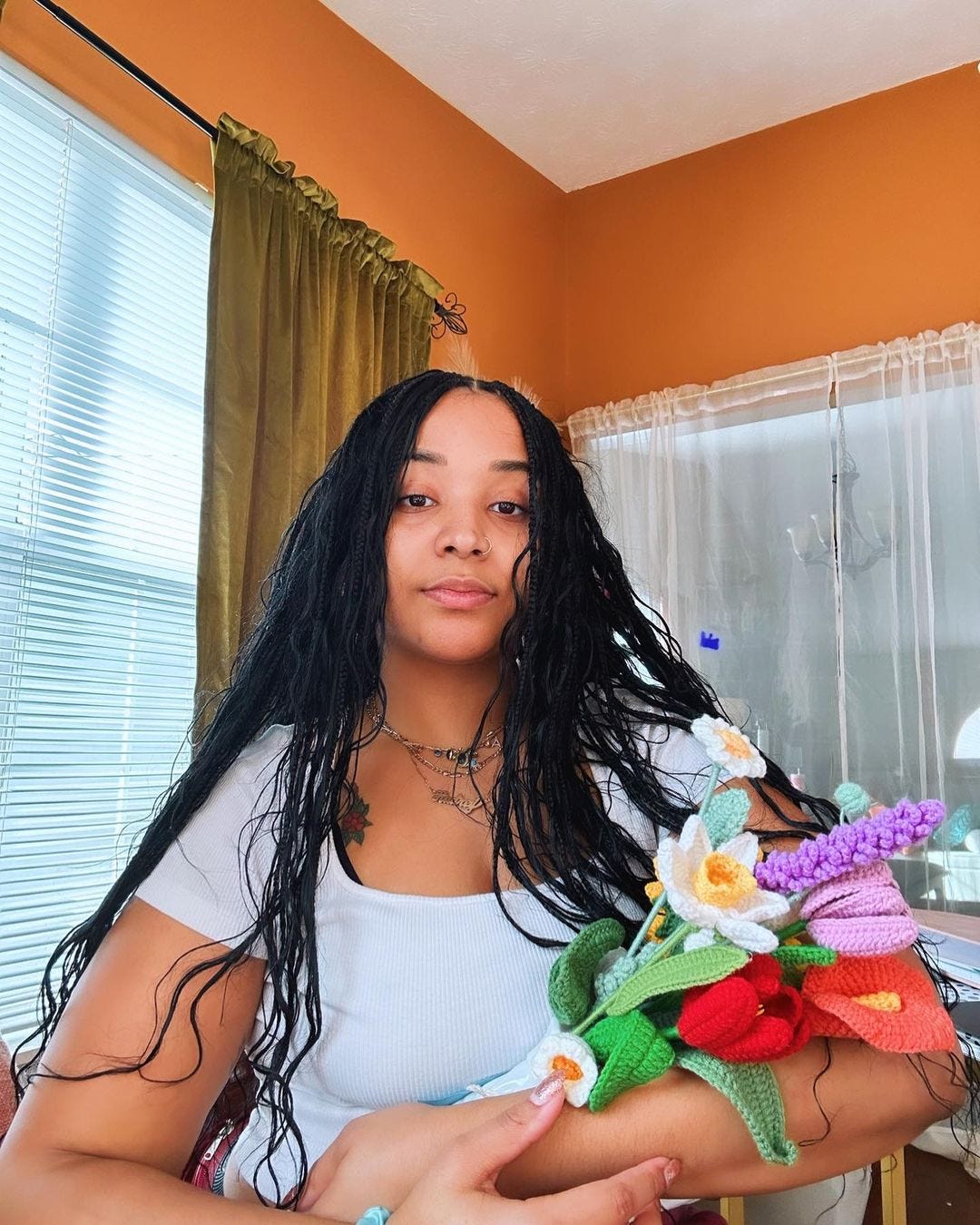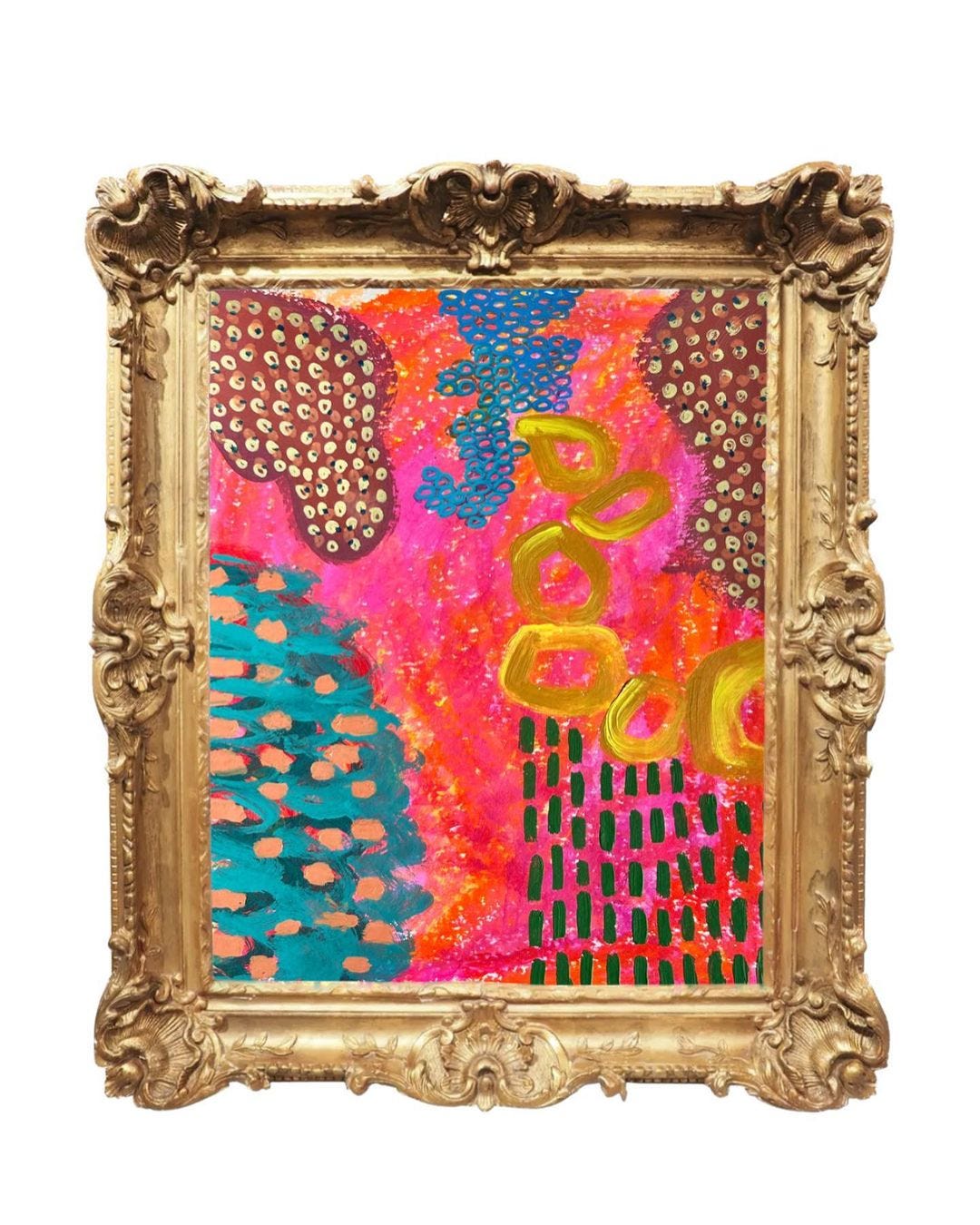Making art with Audrey Williams
Exploring the freedom to create.
Welcome to Thinking About Getting Into: a newsletter about interesting people with interests.
What would happen if you gave yourself the permission to create without judgment? That’s what I discussed with Audrey Williams over coffee one day this summer. Audrey is a writer and overall creative (check out her latest feature for Essence about embracing anger as a Black woman and her documentary on beauty supply shops, Black Girl Church). But in her spare time, she likes to paint. Her paintings are vivid, abstract works of art made out of upcycled framed canvases. Here, she shares how her now-four-year-old daughter Corinne inspired her to lean into the chaos of creation.
This interview has been edited and condensed.
So, painting—how did this all start for you?
Well, I became a mom. So much of my mental power is now spent going, “What can I do with her today?” Kids have to channel their energy somewhere.
It started with me embellishing my daughter’s work—going, “What if we put that there?”—to eventually feeling confident enough to make my own. I started going to Goodwill and getting old paintings with really nice frames and canvases I could paint over. I started painting things that I wanted to see in my home and sharing them online. And it just became a fun thing to do.
That freedom to make a mess—even though I’m the one who has to clean it—was really enjoyable. And it gave me something to do where I wasn’t like, “What do I have to do next?” When I’m painting, I’m just painting. It allows me to be present.
When did you start, and how long were you painting with your daughter before you started to see it as your own hobby as well?
I started around December 2021. She started showing an interest in art, and I figured if I could trust her with markers, maybe I could trust her with paint. I figured, let’s do this together because I had to be there anyway to monitor her. By the end of the following summer, it became almost entirely my thing. She’s a toddler—she wants to do something else now, but it stuck with me.
Not having to think about anything else [while painting] has been so freeing. Writing is a creative endeavor for sure, but it’s like, “Okay, now you have to edit.” Sometimes, it can feel like math to me—if I’m building an article it’s like, “Okay, what’s the intro? I really love this quote and it would fit here, but it would also make a great wrap-up, so let’s make that the last one.” It can feel very formulaic at this point in my career, and I can be very judgmental of my writing. Being a writer is my identity, and therefore I’m very protective of it. I try to be very good at it. As much as I love painting, it’s not my identity. It’s a hobby. I can call myself an artist, but I’m not relying on art to pay my way in.
I’m curious if this is something you’ve struggled with—as someone who loves starting new hobbies, I find it sometimes difficult to not be hard on myself. I’ve definitely gotten better at it, but I know for a lot of people there can be this feeling of wanting to not do something anymore if you’re not immediately good at it. Did you ever feel that way when you started painting?
I don’t know that I did. There were things that I painted that I look back at and go, “I would do that differently now.” But I think because I approached painting with my daughter, it forced me to give up that sense of control where it’s like, “I need it to look like this.” There was this element for me with painting where I would have something in my mind, but that broke when I tried to paint what I saw in my mind and hated it. So I just stated painting anything—and I’d love those paintings more.
The idea of learning from your toddler is also so interesting. What was it like developing your own personal art style as you painted with your daughter?
When we first started, I just let her do whatever she wanted to do. Then when she’d get bored, I’d be like, “Oh, what if we do a little this here, a little that there.” She’d do these scribbles that looked so cool, and I would try to imitate them. You can totally tell which ones are mine because you cannot fake that kind of chaos.
So I leaned into her chaos. I would say, “Let’s draw a cloud,” and she’d pick up green and I’m like, “Well, okay, green clouds today. Why not?”
You know back in school when you’re taking notes in class and you’re drawing hearts, writing your name 15 times in cursive, print, and bubble letters? I have notebooks filled with nonsensical things like that. When my brain needed a break, I’d doodle these blobby cells. I just like making random shapes. So I realized I couldn’t imitate my daughter—I just had to let my brain and hands do the thing.
What kinds of materials do you use?
When I first started, I didn’t want to invest too much. I was like, “Let me get a classic set of 12 acrylic paints, cheap brushes, and start there.” Then I realized, “Oh, but I want to make more colors.” So I actually started going to Home Depot and getting paint samples. Then I did research and learned that you can get paints with a different finish. I started to realize I enjoy doing this.
Then I started getting markers and paint pens for details. I really want to start using glitter, something really sparkly, because that is so on-brand for me. I also really love the contrast of my weird, organic art with old, baroque gold frames that are very traditional-looking. I think it’s the perfect comination.
How often do you keep your own paintings versus giving them away?
I just want to paint and give those paintings away to people. I’m a very sentimental tchotchke person. I have birthday cards from when I was 10. I go through my things and I’m like, “Oh, I remember when they gave me this”—if I can give someone else that feeling, that is very rewarding to me. Sometimes people are like, “You should monetize this!” but honestly, I would do this anyway.
What would you tell someone who’s thinking about getting into painting?
Just get the paint, just get the paper—whatever your medium is, give yourself the space and freedom to do literally anything. And do it for yourself. Do it when you’re bored or have nothing else to do. We all have these pockets where your brain is empty or you start worrying and ruminating. If you need to feel like you’re in control of something, you have the agency to pick up a brush. And you can make something out of nothing and that is the reward. It doesn’t have to be good. It doesn’t have to be moving. You have literally made something out of nothing, and that in and of itself is worth celebrating. ▲




